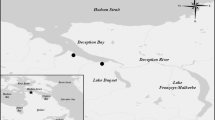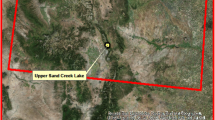Abstract
Concentrations of manganese were determined in the liver, kidney, muscle and bone of white suckers (Catostomus commersoni) from five acid (pH < 5.8), and two circumneutral lakes in south-central Ontario. Manganese tissue concentrations were greater in fish captured from the most acidified lakes with the greatest concentrations of dissolved manganese. These fish had increased concentrations of manganese in the liver, as indicated by a comparison of liver:kidney manganese concentration ratios among the seven fish populations. Tissue concentrations of manganese from all populations either were negatively correlated (P < 0.05) or remained constant with fish size indicating homeostatic regulation of this metal. Manganese concentrations of the benthic fauna were positively correlated to sediment concentrations (R=0.30). Lake sediment manganese concentrations were significantly correlated to maximum lake depth (R=0.80, P < 0.03), with the concentrations in the top 0–1 cm dependent on the redox conditions in the seven lakes. Based on the seven lakes studied, manganese concentrations in the benthic-feeding white sucker correlated better with dissolved manganese, than with either the concentrations in food or surficial sediments.
Similar content being viewed by others
References
Brzezinska, A., A. Balicki & J. C. Van Loon, 1984. Environmental and biological samples analyzed by inductively coupled plasma emission spectrometry. Wat. Air Soil Pollut. 21: 323–333.
Burrows, I. G. & B. A. Whitton, 1983. Heavy metals in water, sediments and invertebrates from a metal-contaminated river free of organic pollutions. Hydrobiologia 106: 263–273.
Cowx, I. G., 1982. Concentrations of heavy metals in the tissues of trout (Salmo trutta) and char (Salvelinus alpinus) from two lakes in North Wales. Envir. Pollut. A 29: 101–110.
Cross, F. A., L. H. Hardy, N. Y. Jones & R. T. Barber, 1973. Relation between total body weight and concentrations of manganese, iron, copper, zinc and mercury in white muscle of bluefish (Pomatomus saltatrix) and a bathyl-demersal fish (Antimora rostrata). J. Fish Res. Bd Can. 30: 1287–1291.
Davison, W. E. & E. Tipping, 1984. Treading in Mortimer's footsteps: the geochemical cycling of iron and manganese in Esthwaite Water. Freshwat. Biol. Ass. 52nd Ann. Rep.: 91–101.
Dickson, W., 1975. The acidification of Swedish Lakes. Inst. Freshwat. Res. Drottningholm. Rep. 54: 8–20.
Elwood, J. W., S. G. Hildebrand & J. J. Beauchamp, 1976. Contribution of gut contents to the concentration and body burden of elements in Tipula spp. from a spring-fed stream. J. Fish Res. Bd Can. 33: 1930–1938.
Evans, H. E., P. J. Smith & P. J. Dillon, 1983. Anthropogenic zinc and cadmium burdens in sediments of selected southern Ontario lakes. Can. J. Fish aquat. Sci. 40: 570–579.
Fraser, G. A. & H. H. Harvey, 1982. Elemental composition of bone from white sucker (Catostomus commersoni) in relation to lake acidification. Can. J. Fish aquat. Sci. 39: 1289–1296.
Goodyear, C. P. & C. E. Boyd, 1972. Elemental composition of largemouth bass (Micropterus salmopides). Trans. am. Fish. Soc. 101: 545–547.
Hakanson, L., 1984. Metals in fish and sediments from the River Kolbacksan water system, Sweden. Arch. Hydrobiol. 101: 373–400.
Harvey, H. H. & C. Lee, 1980. Fishes of the LaCloche Mountain lakes of Ontario 1965–1980. M. Sci. Rep., Ont. Minist. Nat. Resour. 89 pp.
Harvey, H. H., 1983. Manganese content of fishes in relation to lake acidity: A potential diagnostic tool in assessing the distribution and degree of acid precipitation effects. Rep. to Dep. Fish. Oceans, 48 pp.
Helwig, J. T. & K. A. Council, 1979. S.A.S. User's Guide. S.A.S. Inst. Cary, North Carolina, 494 pp.
Henrikson, A. & R. F. Wright, 1978. Concentrations of heavy metals in small Norwegian lakes. Wat. Res. 12: 101–112.
Johansson, K., 1980. Tungmetaller i sura Skogssjöar Rapport Natarvard-sverket SNVPM # 1359, 70 pp. Box 1302 17125 Solna Sweden.
Lockhart, W. L. & A. Lutz, 1977. Preliminary biochemical observations of fishes inhabiting an acidified lake in Ontario, Canada. Wat. Air Soil Pollut. 7: 317–332.
Lind, O. T., 1979. Handbook of common methods in Limnology, 2nd Edn. C.V. Mosby Company, St. Louis, Missouri, 199 pp.
Mathis, J. B. & T. F. Cummings, 1973. Selected metals in sediments, water and biota in the Illinois River. J. Wat. Pollut. Cont. Fed. 45: 1573–1583.
Mathis, J. B., T. F. Cummings, M. Gower, M. Taylor & C. King, 1979. Dynamics of manganese, cadmium and lead in experimental power plant ponds. Hydrobiologia 67: 197–206.
McNichols, C. W., 1984. IBM PC Statistics: Basic programs and applications. Reston Publishing Company, Inc., Los Angeles, California, 338 pp.
Moreau, G., C. Barbeau, J. J. Frenette, J. Saint-Onge & M. Simoneau, 1983. Zinc, manganese and strontium in opercula and scales of brook trout (Salvelinus fontinalis) as indicators of lake acidification. Can. J. Fish. aquat. Sci. 40: 1685–1691.
Namminga, H. & J. Wilhm, 1977. Heavy metals in water, sediments, and chironomids. J. Wat. Pollut. Cont. Fed. 49: 1725–1731.
Ney, J. J. & J. H. Van Hassel, 1983. Sources of variability in accumulation of heavy metals by fishes in a roadside stream. Arch. envir. Toxicol. 12: 701–706.
Norton, S. A. & C. T. Hess, 1980. Sediment dating and chemical stratigraphy. In: D. Drablos & A. Tollan (eds), Proc. int. Conf. Ecol. Impact of Acid Precipitation. SNSF Proj. 1432 As, Norway: 268–269.
Ochsenbein, V., W. Davison, J. Howard & E. Y. Haworth, 1983. The geochemical record of major cations and trace metals in a productive lake. Arch. Hydrobiol. 98: 463–488.
Packer, D. M., M. P. Ireland & R. J. Wootton, 1980. Cadmium, copper, lead, zinc and manganese in the polychaete Arenicola marina from sediments around the coast of Wales. Envir. Pollut. A 22: 309–322.
Patrick, F. M. & M. W. Loutit, 1978. Passage of metals to freshwater fish from their food. Wat. Res. 12: 395–398.
Pentreath, R. J., 1976. Some further studies of the accumulation and retention of 65Zn and 54Mn by the plaice, Pleuronectes platessa L. J. exp. mar. Biol. Ecol. 21: 179–189.
Robbins, J. A., 1978. Geochemical and geophysical applications of radioactive lead. In: J. O. Nriagu (ed.), Biogeochemistry of Lead in the Environment. Elsevier Publishing Co., Amst.: 285–408.
Schofield, C. L., 1976. Acid precipitation: effects on fish. Ambio 5: 228–230.
Smith, P. J., 1983. Sediment chemistry of lakes in the Muskoka-Haliburton study area. Ont. Min. Envir. Data Rep., 11 pp.
Stumm, W. & H. Bilinski, 1973. Trace metals in natural waters; difficulties of interpretation arising from our ignorance on their speciation. In: S. H. Jenkins (ed.), Advances in Water Pollution Research. Proc. 6th int. Conf., Jerusalem: 39–49.
Ting, R. Y., 1973. Distribution of Zn, Fe, Mn and Sr in marine fishes of different feeding habits. In: D. J. Nelson (ed.), Radionuclides in ecosystems, 2. Proc. 3rd natn. Symp. Radioecol. U.S. atom. Energy Comm. Symp. CONF-710501: 709–720.
Trippel, E., 1984. Gonadal development and body growth in the white sucker, Catostomus commersoni, in a group of south-central Ontario lakes having a wide range in acidity and mean depth. M. Sci. Thesis, Univ. Toronto, 167 pp.
Wetzel, R. G., 1975. Limnology. W. B. Saunders Co., Toronto, Ontario, 743 pp.
Wiener, J. G. & J. P. Geisy, Jr., 1979. Concentrations of Cd, Cu, Mn, Pb, and Zn in fishes in a highly organic softwater pond. J. Fish Res. Bd Can. 36: 270–279.
Author information
Authors and Affiliations
Rights and permissions
About this article
Cite this article
Bendell-Young, L.I., Harvey, H.H. Uptake and tissue distribution of manganese in the white sucker (Catostomus commersoni) under conditions of low pH. Hydrobiologia 133, 117–125 (1986). https://doi.org/10.1007/BF00031861
Received:
Revised:
Accepted:
Issue Date:
DOI: https://doi.org/10.1007/BF00031861




